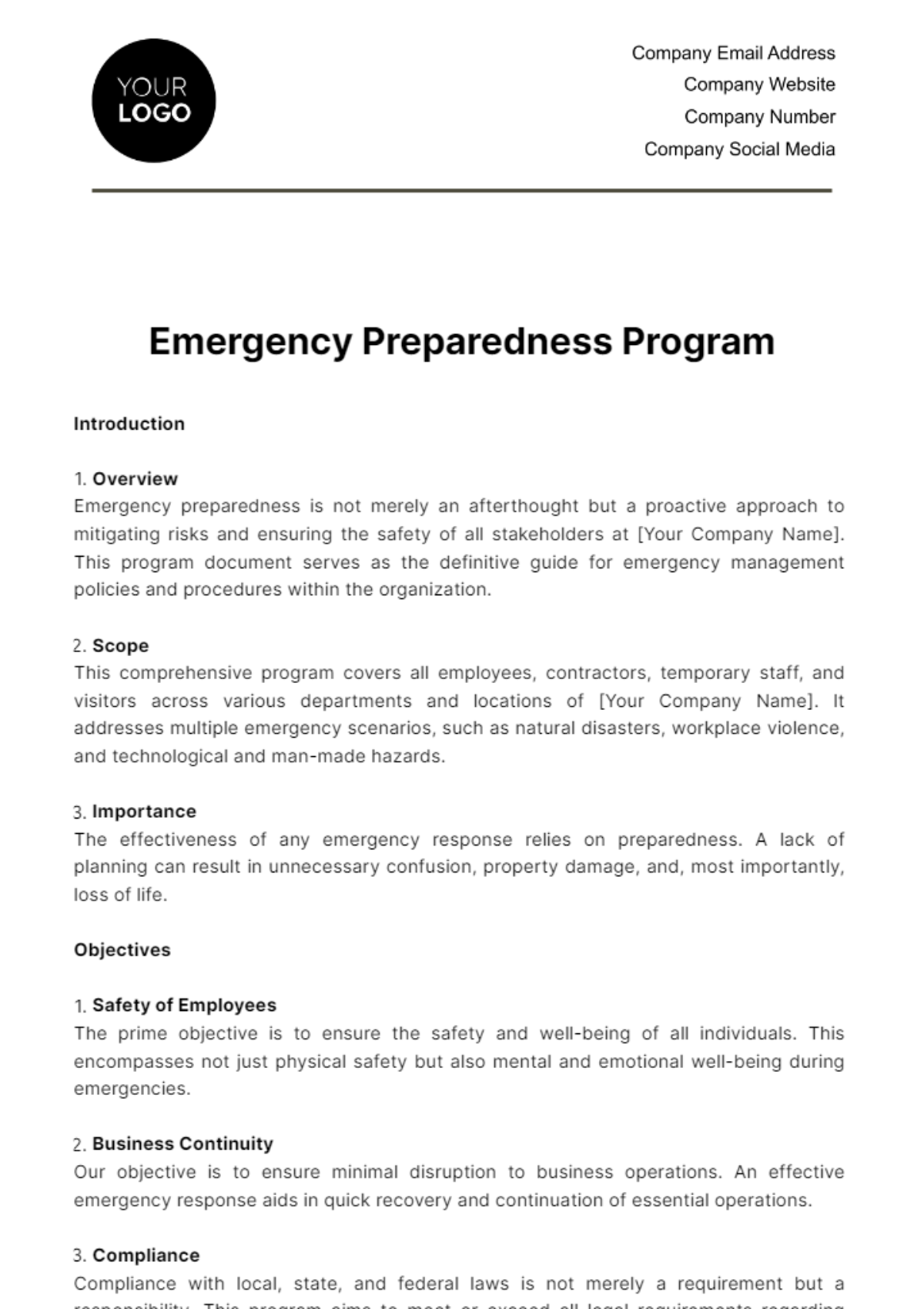Emergency Preparedness Program
Introduction
Overview
Emergency preparedness is not merely an afterthought but a proactive approach to mitigating risks and ensuring the safety of all stakeholders at [Your Company Name]. This program document serves as the definitive guide for emergency management policies and procedures within the organization.
Scope
This comprehensive program covers all employees, contractors, temporary staff, and visitors across various departments and locations of [Your Company Name]. It addresses multiple emergency scenarios, such as natural disasters, workplace violence, and technological and man-made hazards.
Importance
The effectiveness of any emergency response relies on preparedness. A lack of planning can result in unnecessary confusion, property damage, and, most importantly, loss of life.
Objectives
Safety of Employees
The prime objective is to ensure the safety and well-being of all individuals. This encompasses not just physical safety but also mental and emotional well-being during emergencies.
Business Continuity
Our objective is to ensure minimal disruption to business operations. An effective emergency response aids in quick recovery and continuation of essential operations.
Compliance
Compliance with local, state, and federal laws is not merely a requirement but a responsibility. This program aims to meet or exceed all legal requirements regarding emergency preparedness.
Responsibilities
Human Resources
Human Resources will handle overall coordination, including setting training schedules, updating emergency contact lists, and communicating policy changes.
Department Heads
They are responsible for their respective department’s preparedness. This includes ensuring that their team members have been adequately trained and are aware of all procedures.
Employees
Every employee should familiarize themselves with emergency exits, fire extinguisher locations, and emergency contact numbers. Ignorance is not an excuse when it comes to safety.
Risk Assessment
Identification of Hazards
A thorough identification of potential hazards is the first step in risk assessment.
Hazard Type | Risk Level | Mitigation Strategy |
Fire | High | Fire Extinguishers |
Flood | Medium | Elevated Platforms |
Earthquake | Low | Seismic Retrofit |
Assessment Methodology
The risk assessment methodology includes a mix of quantitative and qualitative approaches. Surveys, safety audits, and expert consultations will be conducted annually or when significant changes to the work environment occur.
Emergency Response Procedures
Fire
In case of a fire, immediately sound the alarm and contact emergency services. Follow the established evacuation plan, moving calmly towards the nearest exit.
Flood
During a flood, the building must be evacuated in a systematic manner. Elevators should not be used; instead, stairs should be utilized.
Earthquake
Employees are advised to 'Drop, Cover, and Hold On' during an earthquake. Once the shaking stops, evacuate the building if it is safe to do so.
Communication Plan
Internal Communication
A chain of communication must be established, utilizing company emails, intercoms, and emergency notification systems to relay important messages.
External Communication
The PR department will handle external communications, including press releases and social media updates. Emergency services and external stakeholders will be updated as needed.
Training and Education
Employee Training
Regular training sessions will be organized, covering various types of emergencies. New employees must undergo this training within the first month of their employment.
Mock Drills
Mock drills will be held quarterly. The effectiveness of each drill will be analyzed to make necessary adjustments to the emergency plans.
Resources and Tools
Emergency Kits
Emergency kits, stocked with essentials like water, flashlights, and first aid supplies, will be placed at strategic locations.
Emergency Numbers
A directory of important emergency numbers, including key personnel, local hospitals, and service providers, will be readily accessible.
Review and Update
Annual Review
An in-depth review of this Emergency Preparedness Program will be conducted annually.
Updates
All updates will be communicated through official channels like [Your Company Email] and [Your Company Website].
Appendix
Evacuation Plans
Detailed diagrams of evacuation routes and muster points.
Equipment Manuals
Manuals for operating fire extinguishers, alarm systems, and other emergency equipment.
For more information or queries, please contact [Your Email] or visit [Your Company Website].
HR Templates @ Template.net






























